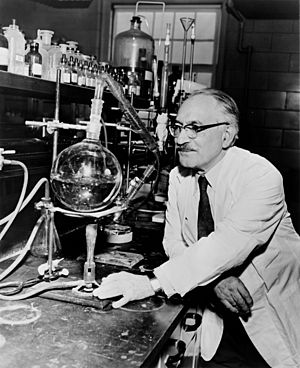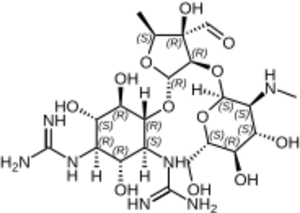Selman Waksman facts for kids
Quick facts for kids
Selman Waksman
|
|
|---|---|
 |
|
| Born | July 22, 1888 Nova Pryluka, Kiev Governorate, Russian Empire (now Ukraine)
|
| Died | August 16, 1973 (aged 85) Woods Hole, Barnstable County, Massachusetts, United States
|
| Citizenship | United States of America (after 1916) |
| Alma mater | Rutgers University University of California, Berkeley |
| Spouse(s) | Deborah B. Mitnik (died 1974) |
| Children | Byron H. Waksman (1919–2012) |
| Awards | Albert Lasker Award for Basic Medical Research (1948) Nobel Prize in Physiology or Medicine (1952) Leeuwenhoek Medal (1950) |
| Scientific career | |
| Fields | Biochemistry and Microbiology |
| Doctoral advisor | T. Brailsford Robertson |
Selman Abraham Waksman (born July 22, 1888 – died August 16, 1973) was an American scientist. He was born in Russia and later became a US citizen.
Waksman was a biochemist and microbiologist. He studied tiny living things in the soil, called microbes. His work led to the discovery of streptomycin and other important medicines called antibiotics.
He taught at Rutgers University for 40 years. He found many antibiotics and helped create the modern meaning of the word "antibiotic."
In 1952, he won the Nobel Prize in Physiology or Medicine. This award was for his "clever and successful studies of soil microbes." These studies led to the discovery of streptomycin.
The money from his discoveries helped create the Waksman Institute of Microbiology. This institute is at Rutgers University in New Jersey.
In 2005, Selman Waksman's work was recognized as an important part of history. His lab found over 15 antibiotics. Streptomycin was the first medicine that could effectively treat tuberculosis.
Contents
Early Life and Education
Selman Waksman was born on July 22, 1888. His family was Jewish and lived in Nova Pryluka, which was part of the Russian Empire. Today, this area is in Ukraine.
In 1910, he moved to the United States. Six years later, he became an American citizen.
Waksman went to Rutgers University. He earned his first degree in agriculture in 1915. He continued his studies there and got his master's degree in 1916.
During his studies, he researched bacteria in soil. He also spent time at the United States Department of Agriculture. In 1918, he earned his PhD in biochemistry from the University of California, Berkeley.
Career and Discoveries
After finishing his education, Waksman joined the faculty at Rutgers University. He worked in the Department of Biochemistry and Microbiology.
Finding New Antibiotics
At Rutgers, Waksman and his team found several antibiotics. These included actinomycin, neomycin, and streptomycin.
He worked with Albert Schatz to discover streptomycin. This was a very important discovery. Streptomycin was the first effective medicine against certain types of bacteria. It was also the first antibiotic used to cure tuberculosis.
Waksman is known for using the term "antibiotics." He used it to describe medicines that come from living organisms. Penicillin is another example of an antibiotic.
Marine Bacteria Research
Waksman also studied bacteria in the ocean. He looked at how bacteria help break down things in the sea. This included studying how they affect important nutrients.
He worked with other scientists on these marine studies. They looked at how many bacteria were in seawater. They also studied how bacteria affect the nitrogen cycle in the ocean.
Waksman Institute of Microbiology
In 1951, Waksman used some of his earnings to create a foundation. This foundation helped build the Waksman Institute of Microbiology.
The institute is located at Rutgers University. It is a place for important research in microbiology.
Personal Life
Selman Waksman was married to Deborah B. Mitnik. They had one son, Byron H. Waksman. Byron also became a scientist and a professor.
Selman Waksman passed away on August 16, 1973. He was buried in Woods Hole, Massachusetts. His tombstone says "Selman Abraham Waksman: Scientist." It also has a quote from the Bible in Hebrew and English.
Research Highlights
Streptomycin Discovery
Waksman had studied the Streptomyces griseus organism for a long time. Streptomycin was found from S. griseus.
One of Waksman's students, Albert Schatz, helped isolate streptomycin. They found it could fight tuberculosis.
Another scientist, Elizabeth Bugie Gregory, also helped confirm these results. Her name was on an early paper about streptomycin's activity.
Neomycin Discovery
Neomycin is another antibiotic discovered by Waksman. He found it with Hubert A. Lechevalier, one of his graduate students. Their discovery was published in the journal Science.
Awards and Honors
Selman Waksman received many awards. He won the Nobel Prize in 1952. He also received honors from Japan and France.
When he received the Nobel Prize, he was called "one of the greatest benefactors to mankind." This was because of the discovery of streptomycin.
The Selman A. Waksman Award in Microbiology is named in his honor. It is given by the National Academy of Sciences.
See also
 In Spanish: Selman Abraham Waksman para niños
In Spanish: Selman Abraham Waksman para niños


